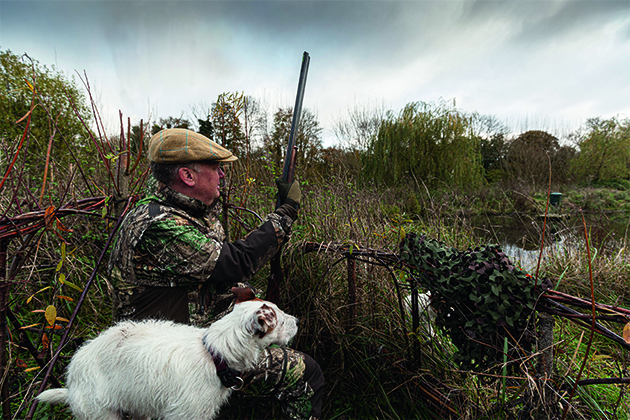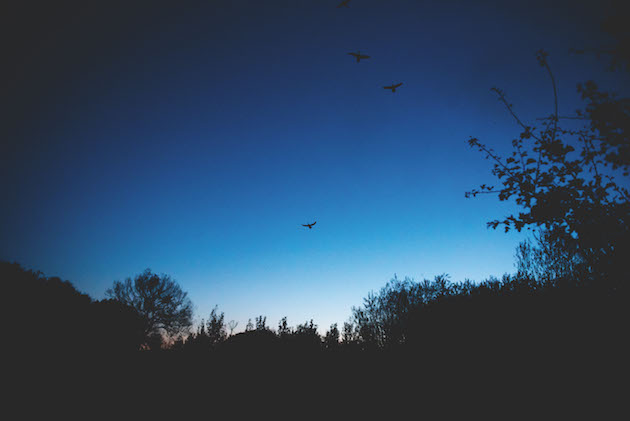How to create or rejuvenate a pond
Creating or rejuvenating a pond is the ultimate conservation quick fix, rapidly providing a rich habitat and sport, as Richard Negus explains

Waiting for duck
Whenever I attend a farm walk organised by the GWCT, I do so with a mixture of emotions. Positive sentiments such as wonderment, revelation and inspiration jostle with less attractive feelings. Frustration and envy largely.
This unwarranted green-eyed state is not due to my begrudging the success of others. Far from it. The more conservation-minded farmers and landowners there are the better in my book. These pangs of jealousy arise because the shoots around which we trudge are already at a point of achievement, while at Flea Barn we are merely at the dawn of our environmental endeavours.
Successful game and wildlife conservation does not happen in the twinkle of an eye. Patience is an essential characteristic of the conservationist and, while I pride myself on being a pragmatist, I have an unrealistic yearning to see the fruits of my labours in short order.
Wildflower blocks and margins require years of tending before they truly become the insect-friendly, grey partridge haven to which we aspire. A newly planted woodland takes a decade or two before it starts to bear habitat fruit. Beetle banks, laid hedges and uncultivated margins need time to mature, like decent sloe gin.
However, there is a salve for those who cannot be patient — the pond. You can sow a veritable sea of cover crops, trap and shoot every predator that the law allows and provide feeding sources with gay abandon, but without water it is all for nothing. Water is, after, all the stuff of life and the added bonus is ponds will bring tangible benefits to your shoot and the creatures that dwell there in months rather than years.
At Flea Barn, we are about to renovate a farm pond as part of a much larger farm wildlife scheme. The pond is not a huge space, an acre at the most. However, it will become a vital tile in the mosaic of habitat that flows like a river across the farm, linking other ponds that are conjoined by hedgerows, wide margins and woodland. This golden acre will not only bring food and sustenance to a wide variety of insect, amphibian, mammal and avian life, it will also provide glorious sport.
The farm pond is superior
I am prepared to stick my neck out and say that, while grouse moors, partridge manors and deeply wooded pheasant valleys are all well and good, the humble mecca for inland wildfowl and waders — the farm pond — is, per square metre, far superior to any of these other more lofty sporting places.
Before you start digging
Before embarking upon digging out your farm pond, it is important to remember a snippet of scripture — “let there be light”. Trees, scrub and cover, if cleared from the southern and western margins of a small body of water, allow sunlight to flood in. It also creates a gentle bank , suitable for duck to waddle out from. The remaining cover to the north and east gives shelter, shade and habitat.
Light enables plant life to become reinvigorated. In 1859, Charles Darwin noted that seeds which had lain dormant for up to a century in pond sediment remained viable. They were merely waiting for exposure to light and air to burst anew into life.
Clearing bankside vegetation encourages dragonflies and damselflies, which prefer an open aspect. Duck, particularly mallard, prefer to have a clear take-off and landing area, though teal are happy to drop vertically into a deep dark hollow.
Once the trees, scrub and vegetation are cleared, the digger’s bucket can work its magic. Your aim is to dig down to the clay layer, which will produce a watertight seal for the pond. This is important if your pond is filled by rain and run off, rather than stream fed. In Suffolk, we are blessed with a clay soil so ponds are easily dug. For other areas, clay must be imported and compacted or a liner used, increasing cost and time.
While the digger driver is at his work, it pays to carve out spaces around the bankside for trapping boxes. Rats and mink need to be controlled and semi-permanent tunnels can be made to look remarkably realistic, with a trap set when required.
When excavating the farm pond, try to create a number of levels. The perfect depth for mallard is around 40cm, teal a mere 15cm. However, deeper delves of up to 2m will help to ensure water remains in the pond all year round and provide rooting places for some of the more elaborate water lillies. The greater the variety of aquatic plants, the more invertebrate life will be sustained. Invertebrates, aquatic molluscs and plants are all natural duck food.
Creating the perfect seedbed
In my experience, the silt that is removed from ponds can be one of two things. If you are fortunate, it is a somewhat inert soil with few nutrients, making it a perfect seedbed for sowing marginal wild flowers. More usually, it is home to a seed bank and broadleaved weeds spring up with ambition. Either top or strim the weeds down or use a weedkiller.
They need controlling if more beneficial plants are to thrive. However, I do like to leave a sizeable clump of nettles — peacock butterflies require the stinging nettle as a nursery for their caterpillars. It also pays huge dividends to create a ‘wetting system’ for an area of your pond margin.
On one pond I built, I simply added a drainage pipe that could be twisted to allow an area to become boggy. The snipe quickly discovered this and they skitter about, delving for food among the reed mace that tends to spring up.
In an ideal world, cattle could be allowed to poach this area. I don’t have cattle, so I tend to tip a few tractor buckets of well-rotted manure on the bog edge. This provides a bounty of brandling worms, which in turn attract pheasants, ducks, waders and a plethora of farmland birds.
On drier margins, wild flower mixes can be sown on the silt. These attract pollinators, whose larvae feed the grey partridges. Greys, while not great drinkers, are attracted to pond margins because of the sheer volume of biodiversity that water brings.
Farm ponds are home to wildlife
The true beauty of farm pond creation is the speed with which a muddy hole becomes a verdant home to wildlife. If the ambition is to shoot over your pond, it is all too tempting to start stocking it with duck. I have written about flightponds in the past and I am not keen on the premise. If a pond has been created or rejuvenated as I have described, wild duck will find you.
Feeders are important, with barley being a sure draw, better still if you can also get access to a small stock of potatoes that are unfit for human consumption.
Scattered around pond margins, the humble spud is to ducks what nepeta is to cats. Shooting wild duck and snipe is a true sporting challenge, but it is one that should be savoured as a fine wine rather than guzzled like supermarket lager.
Wildfowl are not daft, they will swiftly learn that your pond is Circe’s island of Aeaea. While they won’t be turned into swine, they may well become Chinese spiced-duck stir-fry. Do not overshoot your pond, instead enjoy your sport sparingly. Every three or four weeks during the season is more than sufficient.
When not shooting, tend your pond. Build natural hides from willow and simply take half an hour to watch, listen and enjoy what you have created, and observe the change of the seasons. After all, shooting is so much more than merely shooting.











